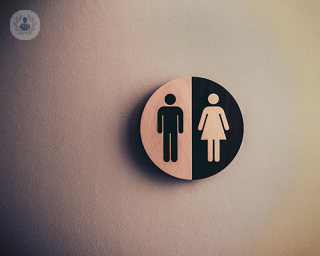What is stress incontinence?
Stress incontinence is the unintentional loss of urine when physical movement puts your bladder under pressure, for example, if you laugh or cough, run, sneeze or lift something heavy. Stress incontinence is much more common in women than in men.
The condition can impact your mental health and those who have stress incontinence may at times feel embarrassed, isolate themselves, or limit social and work life.

What are the causes of stress incontinence?
Stress incontinence is usually the result of damage or weakening of the muscles used to prevent urination (i.e urethral sphincter or pelvic floor muscles).
The bladder expands as it fills with urine. Usually, valve-like muscles in the urethra stay closed as the bladder expands. It prevents urine leakage until you reach a toilet.
However, if these muscles weaken, anything that adds pressure on the pelvic and abdominal muscles can cause pressure on your bladder and cause you to leak urine.
Factors that can increase the risk of developing stress incontinence can include the weakening of muscles. If you’re obese or overweight, the excess weight can increase pressure on the abdominal and pelvic organs.
Prostate surgery is one of the most common causes of stress incontinence in men. When the prostate gland is removed (prostatectomy) to treat prostate cancer this may result in a weakened sphincter.
In women, childbirth can weaken the pelvic floor muscles or the sphincter because of nerve or tissue damage during the delivery of a child. Stress incontinence from this can occur years later or soon after the birth of the child. Hysterectomies can also cause stress incontinence as well as some connective tissue disorders (for example Ehlers Danlos syndrome) and neurological conditions that affect the spinal cord and brain.
How can stress incontinence be treated?
There are a variety of treatment strategies to end or reduce the number of incontinence episodes:
- Pelvic floor muscle exercises – These movements can strengthen your pelvic floor muscles and urinary sphincter.
- Changes to lifestyle – Losing excess weight, treating a chronic cough and quitting smoking, for example, can lessen episodes of stress incontinence
- Training your bladder – Scheduling times to empty your bladder can reduce the severity or number of incontinence episodes.
- Fluid consumption – You may be recommended a certain amount and be given times when you’re allowed to.
- Medication – If you’re unsuitable for surgery or want to avoid having an operation, you may benefit from a medication called duloxetine.
- Devices – Certain devices designed for women may help control stress incontinence
You may be offered surgery if other treatments have been unsuccessful or unsuitable. These are some of the surgery and implant options available:
- Sling procedures – a sling is placed around the neck of the bladder to give support and to prevent leaks.
- Colposuspension – the neck of the bladder is lifted in position to prevent leaks in women with stress incontinence.
- Urethral bulking agents – a substance is injected into the walls of the urethra in women so that they increase in size, stopping leakages as the urethra is better able to stay closed.
- Artificial urinary sphincter – an artificial urinary sphincter is fitted to stop incontinence.
Stress incontinence
Mr Nick Elkington - Obstetrics & gynaecology
Created on: 12-11-2019
Updated on: 09-19-2023
Edited by: Conor Dunworth
What is stress incontinence?
Stress incontinence is the unintentional loss of urine when physical movement puts your bladder under pressure, for example, if you laugh or cough, run, sneeze or lift something heavy. Stress incontinence is much more common in women than in men.
The condition can impact your mental health and those who have stress incontinence may at times feel embarrassed, isolate themselves, or limit social and work life.

What are the causes of stress incontinence?
Stress incontinence is usually the result of damage or weakening of the muscles used to prevent urination (i.e urethral sphincter or pelvic floor muscles).
The bladder expands as it fills with urine. Usually, valve-like muscles in the urethra stay closed as the bladder expands. It prevents urine leakage until you reach a toilet.
However, if these muscles weaken, anything that adds pressure on the pelvic and abdominal muscles can cause pressure on your bladder and cause you to leak urine.
Factors that can increase the risk of developing stress incontinence can include the weakening of muscles. If you’re obese or overweight, the excess weight can increase pressure on the abdominal and pelvic organs.
Prostate surgery is one of the most common causes of stress incontinence in men. When the prostate gland is removed (prostatectomy) to treat prostate cancer this may result in a weakened sphincter.
In women, childbirth can weaken the pelvic floor muscles or the sphincter because of nerve or tissue damage during the delivery of a child. Stress incontinence from this can occur years later or soon after the birth of the child. Hysterectomies can also cause stress incontinence as well as some connective tissue disorders (for example Ehlers Danlos syndrome) and neurological conditions that affect the spinal cord and brain.
How can stress incontinence be treated?
There are a variety of treatment strategies to end or reduce the number of incontinence episodes:
- Pelvic floor muscle exercises – These movements can strengthen your pelvic floor muscles and urinary sphincter.
- Changes to lifestyle – Losing excess weight, treating a chronic cough and quitting smoking, for example, can lessen episodes of stress incontinence
- Training your bladder – Scheduling times to empty your bladder can reduce the severity or number of incontinence episodes.
- Fluid consumption – You may be recommended a certain amount and be given times when you’re allowed to.
- Medication – If you’re unsuitable for surgery or want to avoid having an operation, you may benefit from a medication called duloxetine.
- Devices – Certain devices designed for women may help control stress incontinence
You may be offered surgery if other treatments have been unsuccessful or unsuitable. These are some of the surgery and implant options available:
- Sling procedures – a sling is placed around the neck of the bladder to give support and to prevent leaks.
- Colposuspension – the neck of the bladder is lifted in position to prevent leaks in women with stress incontinence.
- Urethral bulking agents – a substance is injected into the walls of the urethra in women so that they increase in size, stopping leakages as the urethra is better able to stay closed.
- Artificial urinary sphincter – an artificial urinary sphincter is fitted to stop incontinence.


An expert guide to bladder problems
By Miss Victoria Asfour
2024-12-20
Highly esteemed consultant gynaecologist and obstetrician Miss Victoria Asfour shares her expert insight on common bladder and urinary problems and the lifestyle modifications which can help to resolve them in this informative article. See more


Artificial urinary sphincter surgery for the relief of urinary incontinence
By Mr Rowland Rees
2024-12-20
Urinary incontinence refers to the involuntary passage of urine, a common problem that affects up to 3 million people in the UK. If you suffer from severe urinary incontinence, however, the implantation of an artificial urinary sphincter can help to resolve symptoms and improve quality of life. Here, Mr Rowland Rees, renowned consultant urologist and male genito-urethral surgeon, provides an expert insight into artificial urinary sphincter surgery. See more


Overactive bladder in women: Ask an expert
By Mr Arvind Vashisht
2024-12-18
An overactive bladder is a relatively common condition. How do we define an overactive bladder? What causes it and how can it be treated. Leading gynaecologist Mr Arvind Vashisht explains all you need to know. See more


Stress incontinence of urine
By Ms Charlotte Chaliha
2024-12-13
Stress urinary incontinence is a common and distressing symptom that affects 25-45% of women. Risk factors include previous pregnancy, vaginal delivery, obesity, and postmenopausal status. Obstetrician and urogynaecologist in London, Ms Charlotte Chaliha talks about how to stop stress incontinence and who is more at risk. See more
Experts in Stress incontinence
-
Mr Azar Khunda
Obstetrics & gynaecologyExpert in:
- Stress incontinence
- Urogynaecology
- Urinary tract infection
- Vaginal prolapse
- Overactive bladder
- Bladder problems
-
Miss Nadia Rahman
Obstetrics & gynaecologyExpert in:
- Pelvic floor
- Vaginal prolapse
- Stress incontinence
- Urinary tract infection
- Bladder problems
-
Dr Aneta Obloza
Obstetrics & gynaecologyExpert in:
- Urogynaecology
- Vaginal prolapse
- Stress incontinence
- Urinary incontinence
- Bladder problems
- Cystitis
-
Mr Rajagopalan Sriram
UrologyExpert in:
- Bladder cancer
- Stress incontinence
- Haematuria (blood in the urine)
- Urinary tract infection
- Vasectomy
- Vasovasostomy (vasectomy reversal)
-
Mr Nicholas Faure Walker
UrologyExpert in:
- Benign prostate enlargement
- Overactive bladder
- Urinary incontinence in women
- Urinary tract infection
- Stress incontinence
- Prostate
- See all

Guy’s and St Thomas’ Private Healthcare
Guy’s and St Thomas’ Private Healthcare
Guy’s Hospital, Great Maze Pond
No existe teléfono en el centro.
By using the telephone number provided by TOP DOCTORS, you automatically agree to let us use your phone number for statistical and commercial purposes. For further information, read our Privacy Policy
Top Doctors

The Harley Street Clinic - part of HCA Healthcare
The Harley Street Clinic - part of HCA Healthcare
35 Weymouth Street, London. W1G 8BJ
No existe teléfono en el centro.
By using the telephone number provided by TOP DOCTORS, you automatically agree to let us use your phone number for statistical and commercial purposes. For further information, read our Privacy Policy
Top Doctors

The Outpatients and Diagnostic Centre at 30 Devonshire Street (HCA)
The Outpatients and Diagnostic Centre at 30 Devonshire Street (HCA)
30 Devonshire St, London W1G 6PU
No existe teléfono en el centro.
By using the telephone number provided by TOP DOCTORS, you automatically agree to let us use your phone number for statistical and commercial purposes. For further information, read our Privacy Policy
Top Doctors
-
Guy’s and St Thomas’ Private Healthcare
Guy’s Hospital, Great Maze Pond, SE1 South Bank LondonExpert in:
- Allergy
- Cardiology
- General Surgery
- Maxillofacial Surgery
- Thoracic Surgery
- Maternity care
-
The Harley Street Clinic - part of HCA Healthcare
35 Weymouth Street, London. W1G 8BJ, Central LondonExpert in:
- Cancer
- Head and neck cancer
- Cardiology
- Intensive care
- Diagnostic Imaging
- Women’s health
-
The Outpatients and Diagnostic Centre at 30 Devonshire Street (HCA)
30 Devonshire St, London W1G 6PU, Central LondonExpert in:
- Orthopaedic surgery
- Orthopaedic spinal surgery
- Musculoskeletal pain
- Musculoskeletal ultrasound
- Spinal stenosis
- Spinal injections
- See all
- Most viewed diseases, medical tests, and treatments
- Tubal factor infertility
- Complex endometriosis
- Fertility preservation
- Female infertility
- Ovulatory disorders
- Surrogacy
- Menopause support
- Pelvic ultrasound
- Undescended testicle (Cryptorchidism)
- Maternal mental health








